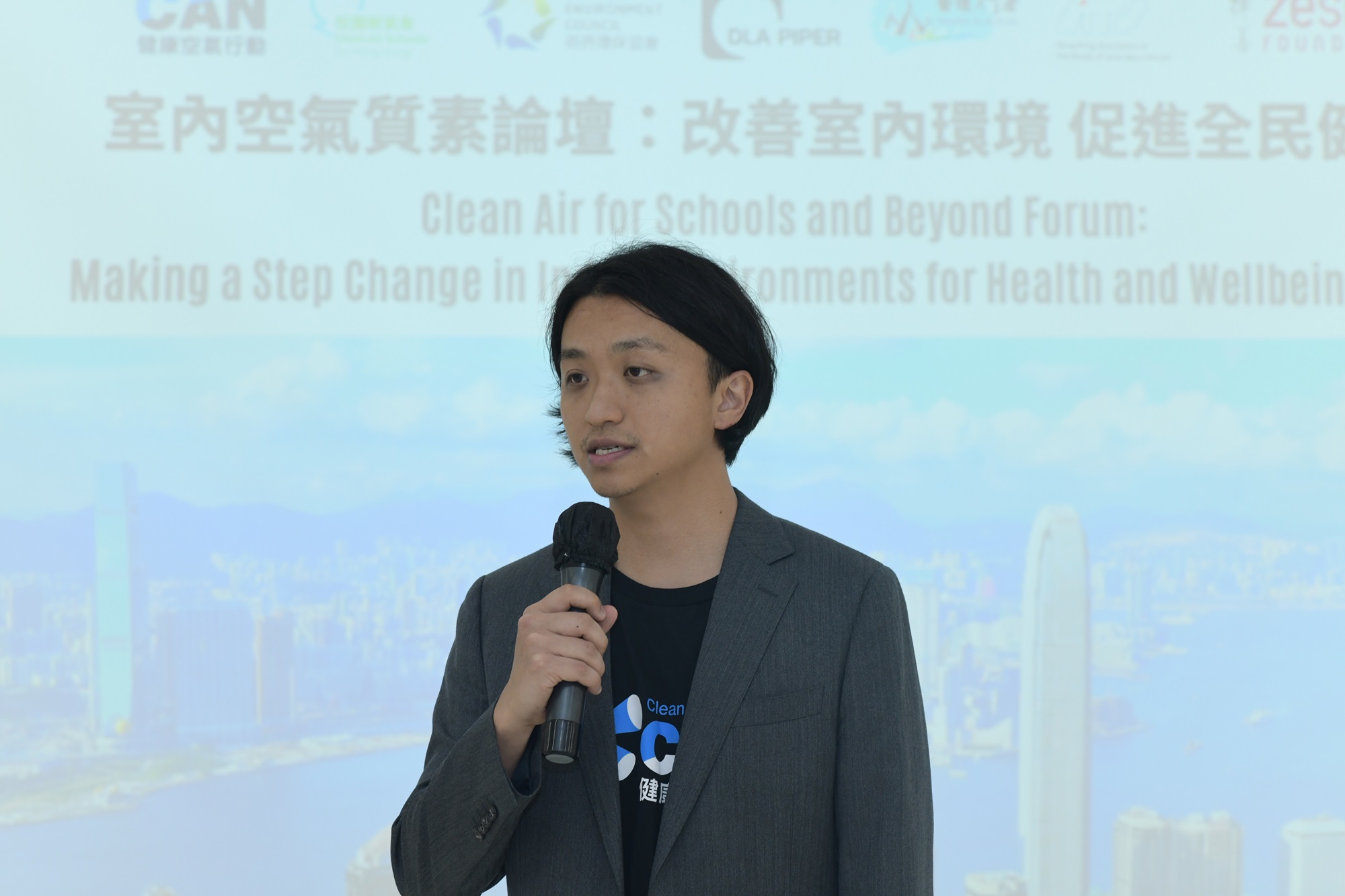
Increasing concerns of indoor air quality after the pandemic highlighted the opportunity to educate and promote related research. In view of this, CAN has collaborated with the Institute for the Environment of the Hong Kong University of Science and Technology (IENV HKUST) from January 2022 to March 2024 on the "Clean Air Schools for Hong Kong" (CASHK) project, which aims to establish the first school-based air monitoring network and provide personalized action plan for eight participated primary schools in the densely populated Sham Shui Po and Tuen Mun districts.
To facilitate discussion, CAN organized the "Clean Air For Schools and Beyond" forum which served as a platform to showcase the outcomes of CASHK and extend the awareness on indoor air and green building to a broader audience beyond schools. By sharing knowledge and experiences gained through this project, inspired individuals, organizations and policymakers to take action and create green and healthy indoor environments across Hong Kong.
Indoor Air Quality Affects School Children's Health Conditions and Cognitive Development
According to data collected from August 2022 to July 2023 for the CASHK project, some participating schools recorded up to 26.9% of the time with a higher AQHI level (level 7 or above) compared to the closest Air Quality Monitoring Stations of the government which showed a moderate level (level 6 and below). This indicates a higher degree of health risk associated with air pollution in schools. The project also found that CO2 levels in most of the classrooms were high averaging approximately 1,100 ppm quarterly, with some classrooms reaching unhealthy levels 50 percent of the time (up to 3000ppm CO2). With CO2 levels that high, it allows bacteria and viruses in the air to remain, increasing the risk of infectious diseases. Students could experience up to an 80% decrease in cognitive functions.
Dr. Zhi Ning, Professor, Institute of Environment, Division of Environment and Sustainability, the Hong Kong University of Science and Technology, said at the forum "The real-time data provides more fluid and efficient insights supporting indoor environment research, which could naturally empower on the education and advocacy front for extending the air monitoring network and encourage behavior change in schools."
Patrick Fung, CEO of Clean Air Network, said "The past two years was a precious journey and a successful experience for us to extend the initiative and drive discussions around indoor environment in Hong Kong. We are encouraged to progressively move towards the direction of educating schools and communities on air pollution, and we hope to use this reliable data to influence government policies to improve air quality and reduce the risk of infectious and non-infectious diseases in the long term."
Indoor Air Quality a Key to Prevent the Next Health Crisis
"Pandemic has called for immediate actions to improve indoor air quality to stop the transmission of virus." said Professor Yuguo Li, Chair Professor of Building Environment, the University of Hong Kong during the forum. With poorly ventilated indoor spaces being the key factor for transmission of virus, Li believes that indoor ventilation equipment, exhaust ventilation systems and air filtration in Hong Kong's public areas or buildings should be improved and regulated to prevent the next pandemic, should another highly contagious respiratory virus emerge.
Building a Healthy Indoor Environment Through Technology, Built Environments and Policy Advocacy
While citizens' health is posed to threat due to poor indoor air quality, there is a consensus that a better use of technology, green buildings and policy enactment could work in synergy and build a healthy indoor environment.
CAN's initiatives aim to transform data and research analysis into actions, making a shift in people's behavior and attitudes to create an ideal indoor environment. Collecting real-time data has therefore become one of the focuses of the forum, with technology playing a vital role. Using the CASHK project as an example, CAN employed a mobile application to instantly record the school's daily AQHI level, share the data and issue alerts when needed on the platform. This could help schools in taking prompt and proactive measures to improve indoor humidity, temperature, and air circulation. Wilson Ip, Engineering Director at Kins Engineering, also talked about the fresh air unit technology and how its system can bring fresh air indoors, reducing people's reliance on air conditioners, as well as briefly explained common misconceptions about using air conditioners to reduce indoor temperature and humidity. He stated that traditional air-conditioning systems may not be able to effectively control indoor humidity and discharge impurities outdoors, but people tend to cope with humidity by lowering the air-conditioning temperature level, forming a vicious cycle on air circulation. However, the fresh air unit enables us to control the indoor and outdoor air circulation and effectively exhaust the contaminants and moisture trapped indoors, providing actual fresh air into the room and save energy at the same time.
In terms of energy saving, carbon emissions and rising temperatures these factors are closely related to air quality. Ar. Dr. Tong Ip, Founder of Tony Ip Green Architects, pointed out that residential density in Hong Kong is high and buildings account for two-thirds of carbon emissions.Yet, aging buildings and property management operations are important factors in enhancing the indoor environment. Zero-carbon and health and wellbeing are two key elements for green building. Different standards, such as BEAMPlus and Construction Industry Council Green Product Certification, can be used to precisely evaluate the energy-saving effect and carbon emissions of buildings. These indicators not only give reliable figures for monitoring green building performance, but they also provide goals and standards for an optimum indoor environment. Given the challenges of aging buildings, old hazardous building materials and property management, Ip highlighted the importance of Hong Kong to promote various green building and property management benchmarks, as well as real-time monitoring, to create a fresh and safe indoor atmosphere.
Melanie Yuen, Associate at DLA Piper, agreed that Hong Kong should pass legislation to tighten oversight of indoor air quality. She stressed that the city's indoor air quality is regulated only through indirect policies, such as "Buildings Ordinance", "Smoking (Public Health) Ordinance" and "Occupational Safety and Health Ordinance". Related schemes, such as the " Indoor Air Quality Certification Scheme for Offices and Public Places", adopted in 2003, is purely voluntary, and its inspection criteria, timeliness and monitoring breadth of data all need to be enhanced. Meanwhile, few rules or laws exist to support the actual operation and implementation of indoor air quality improvement initiatives. She suggested that Hong Kong may draw on the practices of neighboring Asian regions. For example, South Korea has rather strong and thorough regulation. Its "Indoor Air Quality Control Act" sets the indoor air quality standards in some public facilities including subway stations, museums, and new multi-family houses. They also impose fines on facilities that fail to meet the criteria, mandate the installation of ventilation and air purification devices indoors, and require public facility managers to conduct annual monitoring and reporting.
Patrick Fung, CEO of Clean Air Network, concluded "It is critical to encourage indoor air quality in Hong Kong, but this requires the full collaboration of the local government and people from all walks of life, from real-time data collection, education and promotion to behavioral changes and policies. In fact, there is sufficient data basis to support education and legislation to improve indoor air quality in Hong Kong. Last but not least, the discussion at the forum will not end here. We aim to engage more in-depth discussions with other sectors and audiences at future events."
The forum also featured several speaking sessions that explored various aspects of indoor air quality and green buildings. The sessions covered topics such as the relationship between clean air and decarbonization, lessons learnt from the indoor air crisis during the pandemic, barriers and solutions to greening existing buildings and the built environment, new perspectives and approaches for Hong Kong by revisiting the needs and implications for better indoor environments for all, achieving future-ready buildings and built environments, and the way forward to enable green and healthy indoor environments in Hong Kong.
Hashtag: #ClearAirNetwork #IndoorAirQuality #Forum
https://hongkongcan.org/?fbclid=IwAR3OgVn6DH-n6E2hdFzbdwrU5cNd45xbKk8DI4AQosQfFLUmCFlceJA4W-c
https://www.linkedin.com/company/cleanairnetworkhk/?originalSubdomain=hk
https://www.facebook.com/cleanairnetwork/
The issuer is solely responsible for the content of this announcement.
Clean Air Network
Established in 2009, the mission of Clean Air Network (CAN) is to strive to improve Hong Kong's air quality to benefit public health and mitigate climate change through our three key pillars of work, including advocacy, empowerment and knowledge. Without losing sight on air pollution from regional activities, marine vessels and power plants, our present primary focus is on roadside pollution and indoor air impact.
"Clean Air Schools for Hong Kong" project
Clean Air Network (CAN) has partnered with the Institute for the Environment of the Hong Kong University of Science and Technology (IENV HKUST) on the "Clean Air Schools for Hong Kong" (CASHK) project since August 2022. This 24-month initiative aims to establish the first school-based air monitoring network in the densely populated Sham Shui Po and Tuen Mun districts of Hong Kong.
Eight primary schools in these areas have installed air monitoring systems provided by IENV. The project involves analyzing data and proposing solutions, which will be shared with the schools. Additionally, CASHK conducts review meetings with schools and parents to exchange findings and ideas.
The project is funded by ZeShan Foundation and the eight participated schools are S.K.H. St. Andrew's Primary School, St. Francis of Assisi's English Primary School, Society of Boys' Centres Chak Yan Centre School, Chan's Creative School, Yan Chai Hospital Law Chan Chor Si Primary School, A.D.& F.D. of Pok Oi Hospital Mrs. Cheng Yam On Millennium School, Lui Cheung Kwong Lutheran Primary School and HKECA Wu Si Chong Memorial School.
For more information on the project, please visit https://hongkongcan.org/work/clean-air-schools-for-hong-kong/.



















